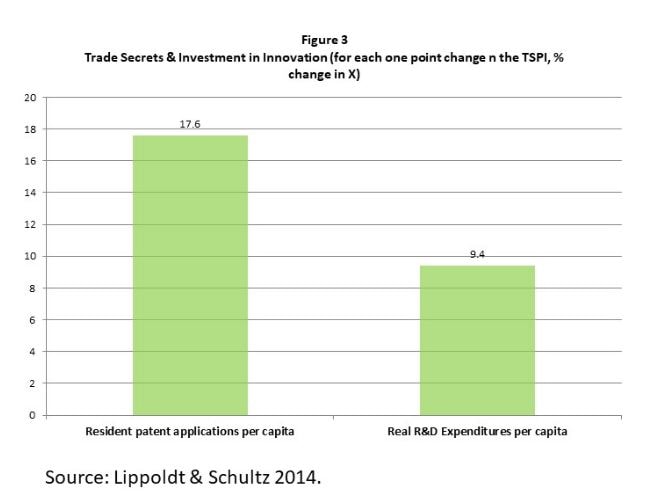Enhancing trade secret protection in India
Why has protecting trade secrets become imperative for nations and businesses? How are trade secrets the key to fostering greater innovation? Professor Mark Schultz suggests how India can address the
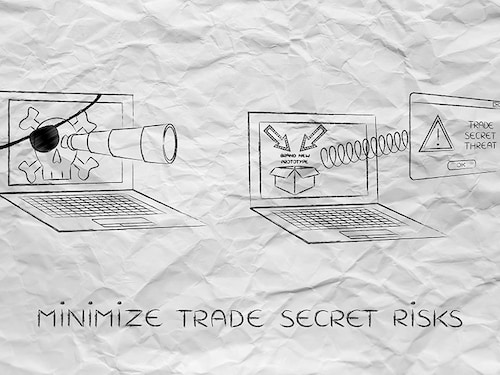

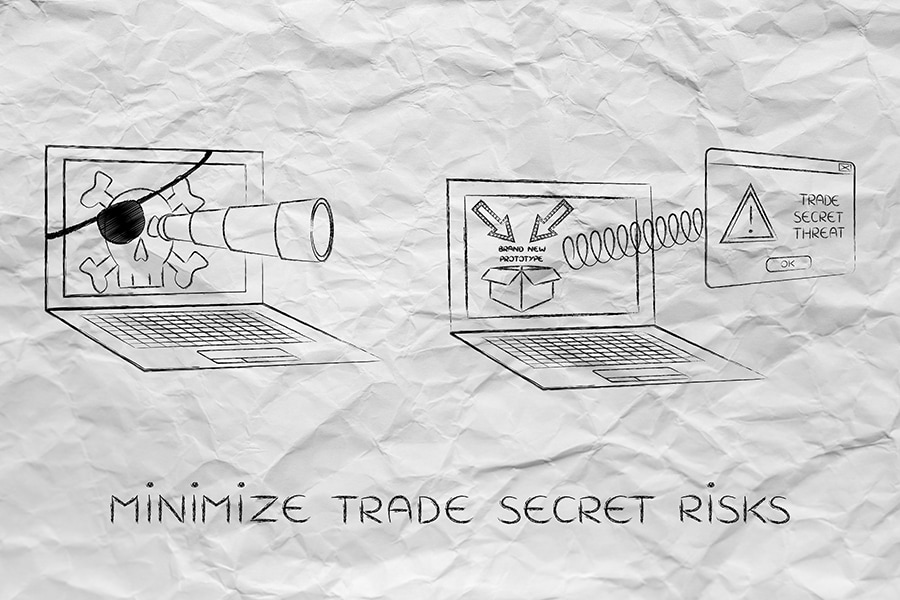 Image: Shutterstock [br]
Image: Shutterstock [br]
Today, innovation has become a precondition for economic success. Effective Intellectual Property (IP) protection aids in securing risky investments in order to innovate and bring new products to the market. This makes IP protection an essential competitive advantage for both businesses and national economies. With the mounting significance of IP protection, a previously obscure IP right, trade secret law, has gained greater prominence.
Trade secret protection is a major 21st century IP issue. For governments, effective trade secret laws are an important part of a well-functioning, national innovation system. For businesses, protecting trade secrets has become increasingly important to investment decisions and success.
Many countries have come to recognise that more effective trade secret protection is a key competitive advantage, but unfortunately, India’s trade secret laws are yet to evolve to meet new challenges. The United States (US), the European Union (EU), Japan, China, South Korea, Taiwan and others have recently enacted new statutes to make their trade secret laws more effective. India’s competitiveness could benefit from following their lead.
This article considers why trade secret protection is important, how India’s trade secret system ranks against other countries and how India could improve its system to create competitive advantage.
What are Trade Secrets and Why are They Important?
The term ‘trade secrets’ is self-explanatory. A trade secret is information, used in business (“trade”) that is not known to the public or others in the industry (“secret”). The requirements for trade secret protection are fairly universal due to the Agreement on Trade Related Aspects of Intellectual Property (TRIPS). To be a member of the World Trade Organisation (WTO), a country must also agree to TRIPS, which sets forth the following requirements for trade secret protection in Article 39:
Trade secret law covers three categories of information: (1) technical information, such as industrial processes and blueprints (2) confidential business information, such as customer lists and (3) know-how, such as business methods for efficiency.
With the digitisation of information, trade secrets have become more vulnerable than ever before. Trade secret laws have thus come into prominence as the digital age has made information easier to steal. Vast amounts of information that once filled file cabinets can now be attached to an email or copied onto a thumb drive.
At the same time, trade secrets are more valuable than ever before. Innovation is the key driver of competitive advantage in the 21st century. Innovation requires research and development, which businesses seek to protect from their competitors. Similarly, an innovation is hardly innovative if everybody else is using it, so businesses try to keep their advantages confidential as long as they can.
The Increasing Embrace of Trade Secret Laws
In recent decades, countries have increasingly recognised the importance of trade secret protection. In 2014, this author, along with co-author Douglas Lippoldt released two studies for the Organisation for Economic Cooperation and Development (OECD) that documented the increasing strength of trade secret systems worldwide (Schultz and Lippoldt 2014). An objective index was created to measure the strength of trade secret systems in about 40 major economies- the Trade Secret Protection Index (TSPI).
The TSPI examines about three dozen objective elements of trade secret protection in national legal systems. Those elements are aggregated into five main components: (1) definitions and coverage (2) specific duties and misappropriation (3) remedies and restrictions on liability (4) enforcement, investigation, discovery and data exclusivity and (5) system functioning and related regulation. The countries are scored on each component based on the absence or presence of these elements, resulting in an aggregate score between 1 – 5.
The data was collected from a diverse global sample of 37 economies from around the world, covering the time period from 1985 to 2010 at five-year intervals. The index captures objective, verifiable information that is comparable across countries. In other words, the index is descriptive, not normative. It is based on facts, rather than a subjective “rating” or opinion.
The TSPI is an innovative effort to create an objective index facilitating international comparisons. Similar indices compare other types of intellectual property and national trade secret laws. For example, Park and Lippoldt (2008) included indices measuring protection of patents, trademarks and copyright in an earlier OECD study, and Professor Ivan Png (2012) developed an indicator measuring trade secret protection across US states. The TSPI differs from these previous efforts in that it is a much more comprehensive, granular examination of the components of an effective law. Expert commentators and practising lawyers often observe that the absence of just a few or even one key component of trade secret protection may render the protection ineffective. The TSPI is thus motivated in part by the need to capture such consequential variations.
It was found that most countries have increased the strength of their trade secret systems since the 1980s. Figure 1 illustrates this evolution. The average OECD economy, which are developed countries, started with a score of around 3.25, which eventually rose to about 4. Brazil, Russia, India, China and South Africa (BRICS) rose even more (from about 1.5 to about 2.75), but still have further to go.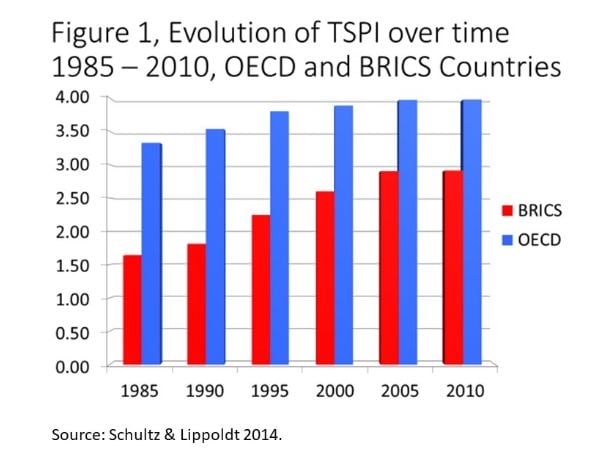 By 2010, many countries had increased the strength of protection of trade secrets, but differences remained (Figure 2).
By 2010, many countries had increased the strength of protection of trade secrets, but differences remained (Figure 2).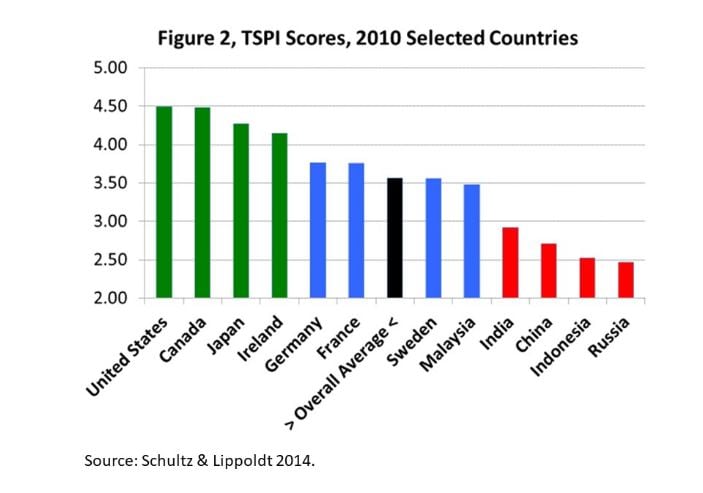 The trade secret laws of countries that score lower on the TSPI tend to share some common, notable omissions, including:
The trade secret laws of countries that score lower on the TSPI tend to share some common, notable omissions, including:
Effective Trade Secret Laws are Important for Innovation
One of the key institutions supporting a company’s innovative capacity is its IP system. A complete and effective IP system includes trade secrets, patents, copyrights and trademarks– working together, these can promote investment in creating new products and bringing them to market. Innovative developments – new products, methods, and processes – typically spring from a research and development (R&D) process. Most R&D is secret, unless or until disclosed. It later may be protected by patents, trademarks and copyrights, although many businesses choose to keep their most valuable information as a trade secret. Metaphorically speaking, patents and trademarks may be the peaks of the innovation system, but trade secrets are the mountain ranges from which those peaks rise.
The OECD study used the TSPI to examine the relationship between trade secrets and economic competitiveness. We found a strong and statistically significant positive relationship between the effectiveness of a country’s trade secret law and key indicators of innovation such as the number of patents and the percentage of GDP spent on R&D.
Figure 3 shows this relationship between TSPI scores and two important measures of innovation.Figure 3 shows that every one-point change in the TSPI, is associated with almost 18% more domestic patent applications per capita and over 9% greater R&D expenditures per capita. As Figure 2 shows, one point on the TSPI is the difference between the TSPI between India and many of its peers. These results support a connection between trade secret protection and innovation. Hence investment in strengthening trade secret laws is a prudent policy.
Effective Trade Secret Laws are Good for Business
Practically every business has secrets that give it an edge over its competitors. The key question for businesses is what they can safely do with their non-public information. Does the law clearly give them the means to protect that information? Are the law and its application sufficiently clear to deter competitors from misappropriating information? If they go to court, will they be able to stop the theft of information quickly? Will the court protect their secrets, or does going to court make it more likely for their secrets getting revealed?
The answers to these questions determine whether a business merely has secrets or whether it has legally-protected trade secret rights. They aren’t the same thing. In both cases, a business must do its best to guard them, but what can the business do if those precautions fail? Without legally-protected trade secret rights, a business has no remedy if an employee quits and wrongly takes secrets with them or an unscrupulous competitor spies out the information.
For all these reasons, businesses rely heavily on effective trade secret laws. In fact, they may be the most important form of intellectual property for businesses. Numerous surveys in various countries with effective trade secret protection confirm the importance of trade secret protection. For example, a survey by Arundel (2001) found that companies in European firms preferred trade secrets to patents, with the preference strongest among smaller businesses. A survey in the U.S. found similar results (Cohen et al. 2000). In many countries, innovative small and medium-size enterprises rely on trade secrets as the default mode of IP protection (Brant and Lohse 2013).
It’s important to observe that trade secret protection isn’t just important from the point of view of IP, but rather as a competitive business strategy. The European Commission sponsored a survey that illuminated the issue. In a survey of 537 businesses in Europe (EC 2013), 75% of respondents ranked trade secrets as “strategically important to their company’s growth, competitiveness and innovative performance.” The survey found that companies of all sizes relied on trade secrets, including small and medium-size enterprises. Another European Union (EU) survey looked at a variety of methods for protecting or increasing competitiveness in business. Figure 4 shows that trade secrecy ranked ahead of all other forms of IP and just behind pure business strategies such as lead time and product complexity.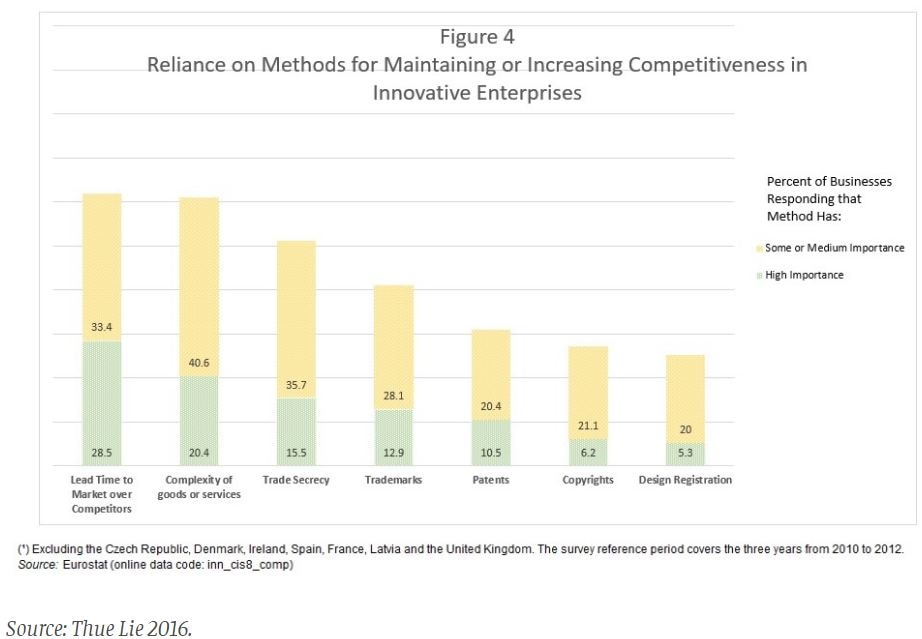 Improving India’s Trade Secret Laws
Improving India’s Trade Secret Laws
There are both bad and good news about India’s trade secret laws. The bad news is that the laws are, in many respects, underdeveloped. The TSPI found that India’s trade secret protection laws lacked many important components, resulting in a very low rank for India on the TSPI. The good news is that India is well-positioned to improve its laws. Trade secret protection relies in part, on the general soundness of the legal system and India’s legal system is relatively strong. For example, enforcing trade secret laws is difficult unless courts provide effective access to evidence and protect confidential information submitted to prove a case. India already does well on both counts. Therefore, unlike some countries with weak legal systems, India can improve trade secret protection by simply clarifying and improving the specific details of its trade secret laws.
Compared to other countries that share an English legal heritage, case law on trade secrets is relatively limited in India. Others with a similar legal heritage have evolved further either through the decisions of courts or through the passage of new laws. Thus, Malaysia, Singapore, Hong Kong and many other countries which started from the same point as India score much higher on the TSPI now, as they have further adapted their laws.
Notable Omissions
A particular omission under Indian law is the failure to sanction the theft of trade secrets by unrelated third-parties, such as unscrupulous competitors. Instead, Indian courts follow an older, English rule which requires a prior relationship between the parties that creates a duty (typically employer-employee) to recognise trade secret theft.
Without a relationship, there is no duty to keep secrets. For example, competitors can eavesdrop or perform other unethical, but not illegal, forms of surveillance to obtain secrets. Similarly, a business that hires another company to perform work may find that its secrets are not protected from the contractor’s employees or subcontractors, as there is no contract or other relationship between the trade secret owner and these other parties.
Other common law jurisdictions have abandoned the relationship requirement for trade secret protection. As the OECD study discusses, case law in the UK, Australia, Canada, Malaysia, Hong Kong and other countries has evolved to prohibit third-party corporate espionage. By contrast, trade secret owners in India still must show the existence of a contract or other prior relationship for trade secrets breaches. This requirement makes it hard to address the growing problem of corporate espionage.
Another notable omission from India’s trade secret laws is the lack of criminal liability. Although used only on rare occasions in most countries, these laws are important. Criminal investigations typically address the most sophisticated corporate espionage – sometimes involving foreign entities or even foreign governments. Trade secret owners rarely have the means or powers to tackle such investigations themselves. Yet another issue is the availability of a preliminary order to stop the use of trade secrets (injunctive relief). Some Indian courts manage this issue well, but commentators have observed that in many courts, prompt injunctive relief is difficult to obtain, and adjudication of the case as a whole, may be slow.
Due to uncertainty and lack of development, one group of Indian experts, in a report to the international IP group International Association for the Protection of Intellectual Property (AIPPI) recommended that India develop a statute: “so that [trade secrets] may be considered as allied rights protected in the same manner as in other intellectual property” (Singh 2010).
The Way Forward
A more modern Indian trade secret law could:
First Published: Dec 04, 2019, 13:52
Subscribe Now